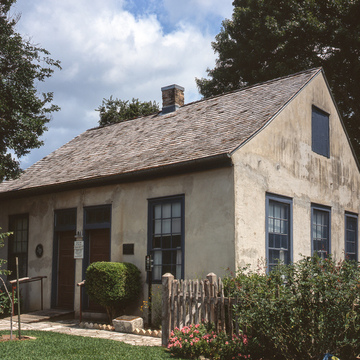The most significant early house in New Braunfels, this small four-room structure was both the residence and office of the founder and publisher of the Neu-Braunfelzer Zeitung. Lindheimer is known as the “father of Texas botany,” being the first to report on the state's flora using scientific methods, collecting specimens that reside in institutions as far afield as England, France, and Russia. A political refugee from Germany, he arrived in Texas in 1836, well in advance of the Adelsverein colonists, serving in the Texas army in the struggle for independence from Mexico, and spending time in Mexico as well. The house, which is owned by the New Braunfels Conservation Society, is Lindheimer's second house, the first being a log building that has long since vanished. This house is of fachwerk construction, with the mortised timber frame filled in with adobe. A coat of stucco covers the framing for protection from the weather, but some of the fachwerk is visible on the interior where the interior plaster has been removed to make it visible to visitors. There are two entrance doors to this four-room-plan house. The left-hand door led to Lindheimer's parlor and bedroom, and the right-hand door provided access to his newspaper office and printing room. The interior of the house was heated by stoves, not fireplaces, in the German tradition, with a single central brick chimney handling the exhaust from all of the stoves.
You are here
Ferdinand Jakob Lindheimer House
If SAH Archipedia has been useful to you, please consider supporting it.
SAH Archipedia tells the story of the United States through its buildings, landscapes, and cities. This freely available resource empowers the public with authoritative knowledge that deepens their understanding and appreciation of the built environment. But the Society of Architectural Historians, which created SAH Archipedia with University of Virginia Press, needs your support to maintain the high-caliber research, writing, photography, cartography, editing, design, and programming that make SAH Archipedia a trusted online resource available to all who value the history of place, heritage tourism, and learning.











